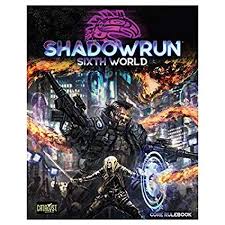I will be posting a full review of the Shadowrun, Sixth World rules. But, in the meantime, I’m gearing up to run a campaign using the rules, one which will include a number of players new to the setting and system. I’m working on my (extensive) notes to help them muddle through, and thought I’d share them with you as well.
The Very Basics
You are creating a character who has recently become a shadowrunner. A shadowrunner is a professional criminal who engages in illegal acts on behalf of others in exchange for pay. You are hired in part for your skills and in part because you are a deniable asset if something goes sideways.
Many of your jobs will be given by megacorporations or their smaller subsidiaries or competitors—these types of jobs often involve corporate espionage, asset destruction, the extraction of personnel or other dirty work that furthers the employer’s bottom line.
Other jobs may come from non-profit organizations willing to break the law for the greater good, private citizens with the means to hire shadowrunners to further their personal agendas, government entities running off-the-books operations, other members of the shadow community, or criminal organizations looking for specialty skills or to bolster their other assets.
A potential employer of a shadowrunner is euphemistically referred to as a “Mr. Johnson” (female employers use various honorifics, whether Ms., Mrs. or Mr.).
A shadowrunner team typically works with one or more Fixers; these go-betweens set up teams with Johnsons and often run procurement or other support roles for a team. The team’s Face may operate as a Fixer, but it is more common for their to be separation (both for efficiency and for operational security) between a team and its Fixer(s).
The Team
Too many skills and expertises are necessary to a successful shadowrun for a single person to handle most jobs alone. ‘Runners typically operate in close-knit teams, where they can share the responsibilities and cover for one another as necessary.
Bear in mind that you will be a team player, so create a character who can be loyal at least to those who have his back.
Good shadowrunner teams strike a balance between each member having a strong expertise and some secondary skills to fill additional roles in the case of a split group, injury to other team members, or other circumstances likely to occur once a perfect plan meets reality.
A Little Terminology
Augmented: A person who has cyberware, bioware, nanoware or some other technological device (usually many) installed in his or her body.
Awakened: When referring to people, this usually means a person with magical ability, whether a mage, a shaman, a physical adept or a mystic adept.
Decker: A hacker, so-called because of the cyberdeck used in hacking.
Mystic Adept: A magic-user who has some of the abilities of a shaman/mage and some of the abilities of a physical adept and, as a consequence of this split, matches neither group in full potency.
Physical Adept: A magic-user who, rather than summoning spirits and casting spells, channels magic (usually passively, but sometimes actively) to improve their physical, mental and social abilities.
Rigger: A user of an augmentation called a “control rig” that allows the user to “jump in” to a vehicle in virtual reality, physically experiencing the operation and function of the vehicle and operating it at the speed of thought. Any properly-equipped vehicle or drone may be jumped into.
Street Samurai: the highly-augmented warrior who adheres to the ancient code of Bushido, slightly modified, of course, for the streets and shadows. Poseurs abound, and true Street Sams are actually rather rare, whatever the trids and games seem to think.
For the next post in the series, with advice on team roles, click here.

[…] For the previous post in this series, click here. […]
LikeLike
[…] FFF’s Guide to 6th Edition Shadowrun Characters, Part I: Basics @ Faith, Fiction & Fatherhood – The first of three articles published by the author on character creation in the latest edition of Shadowrun. I like the positivity the articles have towards an edition that is proving controversial and I also love the great advice offered by the author. […]
LikeLike